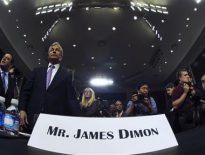(Reuters) – Through phone logs, trading records and a parade of witnesses, U.S. prosecutors repeatedly worked to connect the dots between Rajat Gupta, the former head of top consulting firm McKinsey & Co, and his hedge fund manager friend Raj Rajaratnam.

It is now up to a Manhattan federal jury to decide if this evidence against Gupta, a former board member at Goldman Sachs Group Inc and Procter & Gamble Co, is persuasive enough to convict him.
Historically, insider trading cases have been difficult for prosecutors to win because of their circumstantial nature. The investigation of Rajaratnam — built on eight months of court-approved wiretaps and culminating in his conviction at trial last year — was a major exception because the government had dozens of secretly recorded telephone calls of him discussing stock tips with friends and associates.
In the Gupta case, prosecutors only had a few wiretaps they could use to bolster their charges that Gupta supplied Rajaratnam with some of his juiciest tips. They had no telephone recording between the two men to back one of their most dramatic contentions: that Gupta, a minute after disconnecting from a Goldman board conference call on September 23, 2008, told Rajaratnam about plans by Warren Buffett’s Berkshire Hathaway to inject $5 billion in the investment bank.
The jury heard evidence that Rajaratnam hurriedly ordered his traders at hedge fund Galleon Group to try to buy $40 million worth of Goldman stock in the few minutes that remained in the trading day after he received that 35-second call from Gupta.
“There was only one call to Rajaratnam’s direct line in the last 10 minutes of the trading day, only one call in the last hour,” Assistant U.S. Attorney Richard Tarlowe said in his closing argument Wednesday. “And it was from Rajat Gupta.”
Gupta’s defense lawyer, Gary Naftalis, responded: “If he was truly rushing, he wouldn’t have waited a minute, he would have called in two or three seconds.”
Lawyers following the trial have different opinions about how the jury might view the circumstantial evidence.
JaneAnne Murray, a white-collar defense attorney and professor at the University of Minnesota Law School, said even circumstantial government evidence in the trial could overwhelm the defense’s case.
“The ‘wrong place in the wrong time’ defense works once, maybe twice,” said Murray, who is not involved in the case. “The problem is when one is trying to defuse too many suspicious instances.”
But Chicago securities lawyer Andrew Stoltmann, who is also not involved in the case, said the lack of direct evidence could lead the jury to acquit Gupta. An acquittal would halt the office of Manhattan U.S. Attorney Preet Bharara’s run of victories in a series of insider trading trials over the past 15 months.
Gupta has said all along that he would put up a vigorous defense, describing the prosecutors evidence as purely speculative and circumstantial.
Defense lawyers wanted to play the jury wiretaps of a Goldman Sachs employee tipping off Rajaratnam about other companies to demonstrate that the money manger had other potential sources of information on the firm. The judge ruled that evidence was inadmissible because it was separate from anything in the indictment of Gupta and was likely to confuse the jury.
Gupta is charged with securities fraud and conspiracy, which carry a maximum prison term of 25 years.
BUSINESS AND FRIENDSHIP
Throughout the four-week trial, prosecutors also emphasized the years of friendship and business dealings between Rajaratnam and Gupta as evidence of how the defendant would benefit from conspiring with the hedge fund manager.
They also pulled out some star witnesses, including Goldman Chief Executive Officer Lloyd Blankfein, who testified that board conversations were always confidential and that he never authorized Gupta to share material corporate information with an outsider.
Defense lawyers sowed a few seeds of reasonable doubt, arguing that their client had no motive to leak inside information. They presented evidence that Rajaratnam had cheated Gupta out of $10 million in a joint investment called Voyager Capital Partners. The defense said the two had had a falling out in 2008.
Gupta’s lawyers suggested that their client’s calls to Rajaratnam could have been about the Voyager investment. “He was trying to get information on Voyager, and it had nothing to do in the world with Berkshire Hathaway,” Naftalis said.
Geetanjali Gupta, the eldest of the defendant’s four daughters, testified to her father’s distress over Rajaratnam’s handling of the investment at the time.
The jury also heard from associates and old friends that Gupta was respected for his integrity and had nothing to gain financially from helping Rajaratnam.
“There will be a lot discussion in the jury room about motive and lack of motive,” said Tom Dewey, a partner at law firm Dewey Pegno & Kramarsky in New York, who is not involved in the trial.
The jurors paid very close attention throughout the trial to both sides of the case, with about half of them taking notes on yellow legal notepads.
Gupta at one point appeared likely to testify, but in the end did not.
He may have missed a chance to tell the jury his version of events, create more reasonable doubt and bring out more about his work in efforts to fight AIDS, malaria and tuberculosis in developing countries.
“Better than his lawyer, nobody could have sold the explanation better than Gupta as to why he did what he did,” said securities lawyer Stoltmann.
The most important wiretaps in the case were conversations between Rajaratnam and two of his senior employees.
In one call, the day after the Buffett investment announcement, Rajaratnam told trader Ian Horowitz: “I got a call at 3:58, right? … Saying something good might happen to Goldman.”
On October 24, 2008 Rajaratnam is caught on the wiretap telling portfolio manager David Lau: “Um, now I, I heard yesterday from somebody who’s on the board of Goldman Sachs, that they are gonna lose $2 per share. The Street has them making $2.50.”
Prosecutors said Gupta had called Rajaratnam on October 23, 2008, only 23 seconds after a Goldman board meeting heard the firm was headed toward its first quarterly loss ever as a public company.
The case is USA v Gupta, U.S. District Court for the Southern District of New York, No. 11-907.
(Additional reporting by Basil Katz; Editing by Martha Graybow and Lisa Von Ahn)





